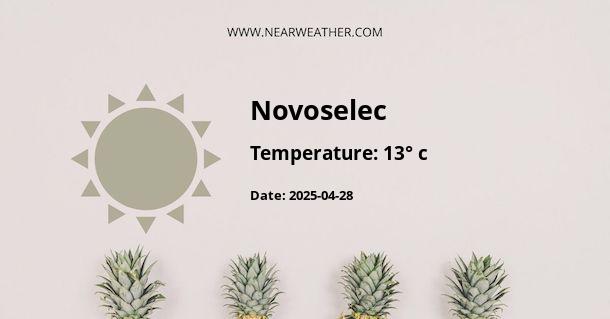Climate and Weather Overview of Novoselec, Croatia
Located in Croatia, a country with a diverse range of climate zones, Novoselec is a small settlement that experiences the nuances of a Continental climate. This region's weather patterns are characterized by warm summers and cold, snowy winters, with transitional spring and autumn seasons. Understanding the intricacies of Novoselec's climate is essential for planning activities, agriculture, and for residents to prepare for seasonal changes.
Seasonal Climate Variations
In Novoselec, as in most of continental Croatia, there are four distinct seasons—spring, summer, autumn, and winter. Each has its characteristic weather patterns:
- Spring: Starting from March, the spring season brings increasing warmth with occasional rain showers. Average daily temperatures gradually rise from about 10°C (50°F) in March to 20°C (68°F) by May. Nights remain cool, especially early in the season.
- Summer: Between June and August, temperatures are typically warm, reaching average highs around 26°C (79°F). Heat waves with temperatures exceeding 30°C (86°F) can occur. Summer also tends to be the driest part of the year, albeit with possible thunderstorms.
- Autumn: Autumn months bring cooler weather, with September highs averaging 21°C (70°F) and dropping to around 10°C (50°F) by November. Precipitation increases, and foggy mornings are common. Late autumn can see the first snowfalls.
- Winter: From December through February, Novoselec experiences its coldest period. Average highs are just above freezing, around 2°C (36°F), and lows can dip to -5°C (23°F) or colder. Snowfall is common, and snow cover can last for several days or weeks.
| Month | High / Low (°C) | Precipitation (mm) |
|---|---|---|
| January | 2 / -5 | 50 |
| February | 4 / -3 | 45 |
| March | 10 / 0 | 55 |
| April | 16 / 5 | 60 |
| May | 21 / 10 | 75 |
| June | 26 / 15 | 100 |
| July | 28 / 17 | 80 |
| August | 27 / 16 | 90 |
| September | 21 / 11 | 85 |
| October | 16 / 7 | 80 |
| November | 10 / 2 | 85 |
| December | 3 / -4 | 65 |
Weather Extremes and Climate Events
Extreme weather events, while not frequent, can occur in Novoselec:
Due to the Continental climate, Novoselec can experience significant temperature fluctuations that may lead to extreme cold spells in winter or scorching heat waves in summer. Sudden thunderstorms during the warmer months can bring short periods of heavy rainfall, posing a risk for local flooding.
Annual Weather Trends
The broader climate trends impacting Novoselec are reflective of wider patterns across the European continent. Analyses conducted by meteorological organizations indicate a slow but steady change in the following meteorological variables:
- Temperature: An observed gradual increase in average temperatures, contributing to milder winters and hotter summers.
- Precipitation: Variability in rainfall patterns often results in wetter springs and autumns, with anomalies in seasonal distributions.
- Snowfall: The total snowfall in winter may exhibit a declining trend, altering the expected snow cover duration and intensity.
- Extreme Events: Increased frequency of extreme events, such as powerful storms and heatwaves, has been observed.
The observed changes are consistent with global climatic shifts often attributed to human-induced climate change.
Impact of Weather on Lifestyle and Economy
The local climate influences several aspects of life and economic activity in Novoselec:
- Agriculture and Forestry: Seasonal weather patterns dictate sowing and harvesting times. Proper management is crucial to mitigate the impact of weather extremes on crop yield and forest health.
- Tourism: As activities are often outdoor-based, having an understanding of seasonal weather trends is vital for the tourism industry to adapt and plan events or attractions.
- Infrastructure: Winter conditions require robust infrastructure for snow removal and road maintenance, as well as flood defenses during wet periods.
- Energy Consumption: Seasonal temperatures drive heating demands in winter and cooling demands in the summer, influencing energy planning and policy.
Long-Term Climate Considerations
Given the dynamic changes in weather patterns, long-term strategies are necessary:
- Climate Adaptation Strategies: Authorities and local communities must design flexible strategies to adapt to changes in the climate, such as building more resilient infrastructure.
- Renewable Energy Integration: Emphasizing renewable energy sources can reduce dependence on fossil fuels and help mitigate extreme weather impacts.
- Water Conservation: As precipitation patterns become more unpredictable, measures to ensure an adequate water supply are essential.
- Ecosystem Preservation: Protecting natural landscapes and biodiversity helps maintain local climate stability and resilience.
Conclusion
With a profound understanding of the climate and weather in Novoselec, Croatia, residents and visitors alike can better prepare for its seasonal variations and adapt to long-term climate trends. The detailed overview presented here indicates climate and weather expectations throughout the year, along with considerations for the potential impacts on life and economy. Localized weather data and climate studies remain invaluable for planning and policy-making, ensuring a proactive response to our ever-changing environment.
Note: The climate data provided herein is based on historical records and might not reflect the most current climate trends. For precise weather forecasts and the latest climate updates, always consult official meteorological sources.
A - Novoselec's Latitude is 45.652500 & Longitude is 16.536390.
A - Weather in Novoselec is 13° today.
A - Climate Conditions in Novoselec shows clear sky today.
A - Humidity in Novoselec is 74% today.
A - Wind speed in Novoselec is 9.04 km/h, flowing at 76° wind direction. today.
